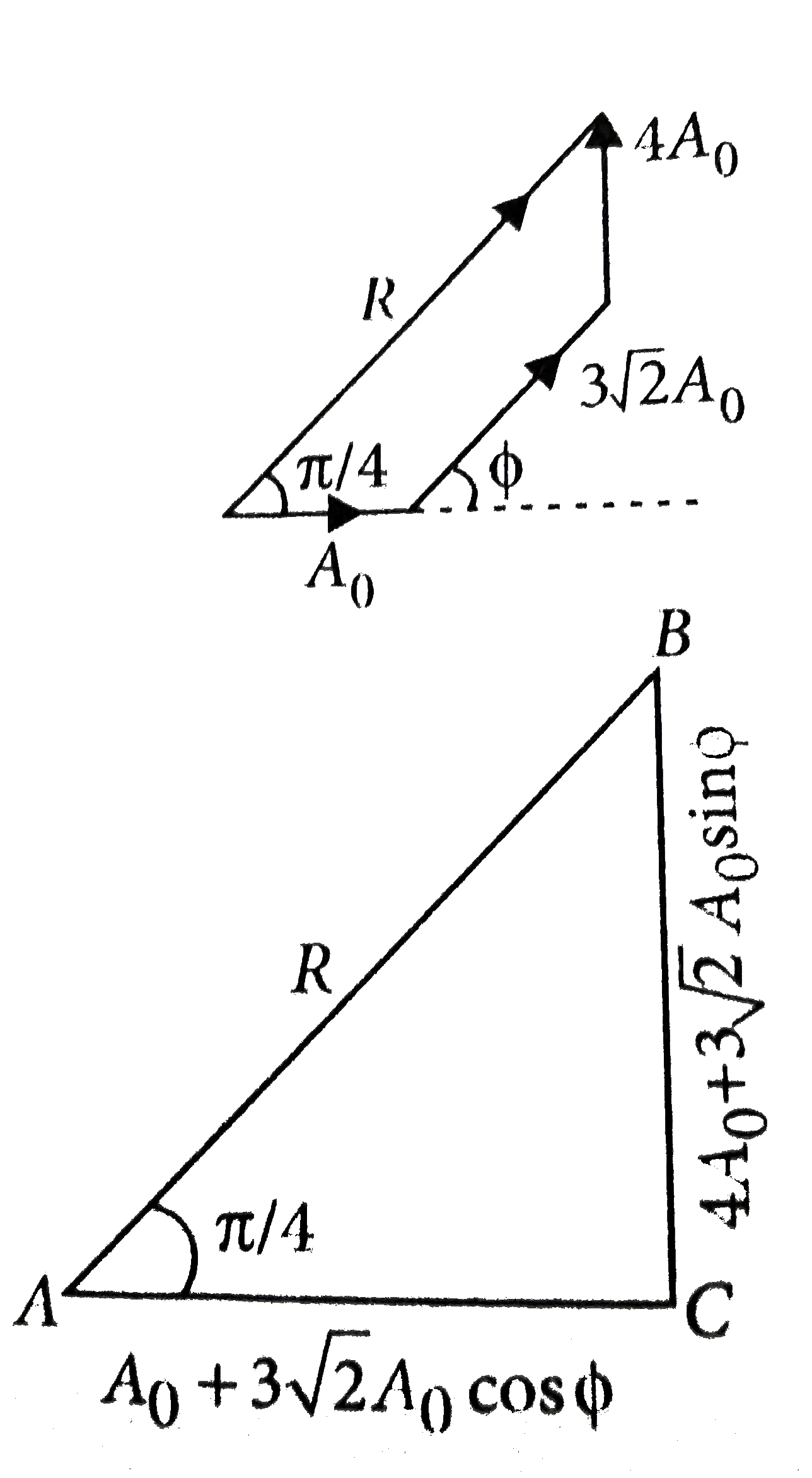Three travelling waves are superimposed. The equations of the wave are
y!=A0sin(kx−ωt),y2=3√2A0sin(kx−ωt+ϕ) and y3=4A0cos(kx−ωt)
find the value of ϕ(given 0≤ϕ≤π/2) if the phase difference between the resultant wave and first wave is π/4
π6
π3
π12
None of these
The correct Answer is:C
Given, y1=A0sin(kx−ωt)
y2=3√2A0sin(kx−ωt+ϕ),
and y3=4A0cos(kx−ωt),

These waves can be represented by phase diagram as shown.
From phase diagram,
tan(π4)=BCAC=A0(4+3√2sinϕ)A0(1+3√2cosϕ)
⇒ 4+3√2sinϕ=1+3√2cosϕ
⇒ cosϕ−sinϕ=1√2
Squaring both sides, we get
cos2ϕ+sin2ϕ−2sinϕcosϕ=12
1−2sinϕcosϕ=12 or 2ϕ=π6⇒ϕ=π12
Topper's Solved these Questions
- BOOK - NCERT FINGERTIPSCHAPTER - WAVESEXERCISE - NCERT Exemplar10videos
WAVES
- BOOK - NCERT FINGERTIPSCHAPTER - WAVESEXERCISE - Assertion And Reason15videos
WAVES
- BOOK - NCERT FINGERTIPSCHAPTER - WAVESEXERCISE - Doppler Effect10videos
WAVES
- BOOK - NCERT FINGERTIPSCHAPTER - UNITS AND MEASUREMENTSEXERCISE - Assertion And Reason15videos
UNITS AND MEASUREMENTS
- BOOK - NCERT FINGERTIPSCHAPTER - WORK , ENERGY AND POWEREXERCISE - Assertion And Reason15videos
WORK , ENERGY AND POWER
Similar Questions
Three travelling waves are superimposed. The equations of the wave are
y!=A0sin(kx−ωt),y2=3√2A0sin(kx−ωt+ϕ) and y3=4A0cos(kx−ωt)
find the value of ϕ(given 0≤ϕ≤π/2) if the phase difference between the resultant wave and first wave is π/4View SolutionTwo waves are represented by
y1=a1cos(ωt−kx) and
y2=a2sin(ωt−kx+π/3)
Then the phase difference between them is-View Solution
Knowledge Check
- Question 1 - Select One
Two sinusoidal waves are superposed. Their equations are
y1=Asin(kx−ωt+π6)andy2=Asin(kx−ωt−π6)
the equation of their resultant isAA√3sin(kx−ωt)BA√3sin(kx−ωt)CA√3sin(kx−ωt−π3)DA√3sin(kx−ωt−π2) - Question 2 - Select One
Three waves y1,y2,y3 are given by y1=Asin(Kx−ωt),y2A=sin(Kx+ωt)andy3=Asin(Ky−ωt). Which one of the following represents wave ?
Ay1+y2+y3By1+y3Cy1+y2Dy2+y3 - Question 3 - Select One
Two waves are represented by
Y1=a1cos(ωt−kx)andY−2=a2sin(ωt−kx+π/3)
Then the phase difference between them is-Aπ3Bπ2C5π6Dπ6
Find the amplitude of the resultant wave produced due to interference of two waves given as,
y1A1sinωt,y2=A2sin(ωt+ϕ)View SolutionWhich two of the following waves are in the same phase?
y=Asin(kx−ωt)
y=Asin(kx−ωt+π)
y=Asin(kx−ωt+π/2)
y=Asin(kx−ωt+2π)View SolutionTwo waves y1=asin(ωt−kx) and y2=acos(ωt−kx) superimpose at a point :
View SolutionAn em wave going through vacuum is described by E=E0sin(kx−ωt)
B=B0sin(kx−ωt)View SolutionAn em wave going through vacuum is described by E=E0sin(kx−ωt)
B=B0sin(kx−ωt)View Solution

